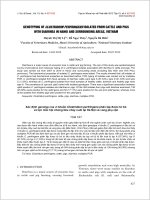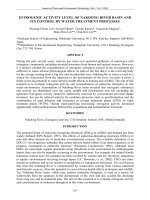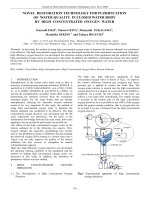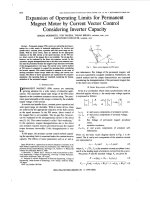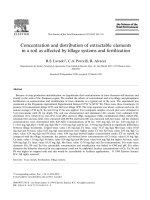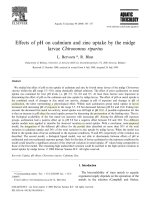Bioremediation of recalcitrant textile azo dye - Methyl orange by bacillus subtilis BRTSI-3 Isolated from textile effluents
Bạn đang xem bản rút gọn của tài liệu. Xem và tải ngay bản đầy đủ của tài liệu tại đây (397.08 KB, 7 trang )
Int.J.Curr.Microbiol.App.Sci (2018) 7(7): 4361-4367
International Journal of Current Microbiology and Applied Sciences
ISSN: 2319-7706 Volume 7 Number 07 (2018)
Journal homepage:
Original Research Article
/>
Bioremediation of Recalcitrant Textile Azo Dye - Methyl Orange by
Bacillus subtilis BRTSI-3 Isolated from Textile Effluents
M. Meenatchi1, K. Shilpa1, D. Nithya1, K. Soniya1, S. Sunila1, S. Nandhini1,
Kayeen Vadakkan2, A. Vidhya1, S. Ramya1 and J. Hemapriya1*
1
2
Department of Microbiology, D. K. M College for Women, Vellore, Tamil Nadu, India
Bioresource Technology Lab, Department of Biotechnology, Thiruvalluvar University,
Vellore, Tamil Nadu, India
*Corresponding author
ABSTRACT
Keywords
Azo Dyes, Bacillus
subtilis, Decolorization,
Effluent, Methyl orange
Article Info
Accepted:
25 June 2018
Available Online:
10 July 2018
Textile effluent samples collected from dye contaminated area of Ranipet, Vellore have
been used for isolating bacterial strains. Among various bacterial isolates, BRTSI-3 was
selected and was further characterized using morphological and biochemical analysis. 16S
rDNA sequencing confirmed the strain BRTSI3 as Bacillus subtilis (NCBI accession
number MH412808). The culture conditions for maximizing bacterial biomass were found
to be optimized at 35oC and pH 8.0. Bacillus subtilis effectively decolorized methyl orange
in nutrient broth within 48 h of incubation. Spectrometric methods such as UV- Vis
spectrophotometry and FTIR were used for assessing the decolorization extent of methyl
orange by BRTSI3. FTIR results confirmed the breakdown of methyl orange by bacterial
metabolites. The investigation proved that the microorganisms found in textile effluent are
capable of decolorizing and degrading the azo compounds of textile effluent.
Introduction
Colors play a major role in day to day life. To
fulfill the need of the customers, commodities
are colored in different shades and patterns.
Dyes and dyestuffs were used to impart color
in pharmaceutical, textile and food industries
(Ayed et al., 2011). More than 10,000 dyes are
commercially available in the market. About
60 % of commercially available dyes are
azodyes. Azo dyes are distributed in three
different classes namely monoazo, diazo and
triazo (Weber and Adams, 1995). These dyes
are considered to be highly recalcitrant
molecules, as they are very difficult to degrade
by microorganisms and as a result, pose a
serious threat to environment leading to water
and soil pollution affecting flora and fauna.
About 10-15 % of dyes used in textile
industries do not fix to the fibers, and
discharge as waste into the treatment plant or
into the environment directly and causes
environmental pollution (Cetin et al., 2008).
Higher organic or inorganic load with intense
heat, color, alkali or acidic nature of the
effluent convert them into highly recalcitrant.
Numerous literature sources provide us
knowledge about removal of azodyes by the
4361
Int.J.Curr.Microbiol.App.Sci (2018) 7(7): 4361-4367
means of physical, chemical and biological
methods. Microorganisms were found to be
the ideal candidates in the field of
bioremediation. Microbes such as fungi, algae,
bacteria and actinomycetes were used as an
alternative for physio-chemical treatment
methods. Bioremediation has proved to a
feasible process for removal of hazardous dye
from the ecosystem. According to Jadhav et
al., (2008), microbial consortium containing
Bacillus sps. and Galactomyces geotrichum
showed effective degradation of Brilliant blue
G dye. Bacillus species was reported to
decolorize methyl orange effectively (Ali,
2005).
Detoxification studies including phytotoxicity
and microbial toxicity assay also proved that
the degraded compounds are nontoxic when
compared to the parental azo compounds
(Parshetti et al., 2010). Work done by Shah et
al., (2013) proved that Pseudomonas sps was
found to decolorize methyl orange efficiently
and also proved that the strain can tolerate
higher concentration of dye which makes them
a right choice for their exploration in the
textile effluent treatment plant. In the present
study, bacterial strain isolated from effluent
sample of textile industry was characterized
by morphological, biochemical and molecular
sequencing (16SrRNA). The efficacy of
isolate in decolorizing methyl orange was
performed quantitatively by using UV-Vis
spectrophotometry and FTIR analysis.
Materials and Methods
Sampling Sites
The sampling area in this study was the textile
industries and dyeing units located in and
around Arani, Thiruvannamalai District, Tamil
Nadu, India. The effluent samples from both
textile industries and dyeing units were
characterized by its dark color and extreme
turbidity.
Azo Dye Used
The commonly used textile azo dye, Methyl
Orange used in this study was procured from a
local textile dyeing unit. Stock solution was
prepared by dissolving 1 g of azo dye in 100
ml distilled water. The dye solution was
sterilized by membrane filtration. All the
chemicals used in this study were of the
highest purity available and of an analytical
grade.
Isolation and Screening of Bacterial Strains
Decolorizing Methyl Orange
The effluent samples were serially diluted and
spread over nutrient agar medium containing
50 ppm of azo dye. pH was adjusted to 7.0
before autoclaving and incubated at 37°C for 5
days. Colonies surrounded by halo
(decolorized) zones were picked and streaked
on nutrient agar plates containing azo dyes.
The plates were re-incubated at 37°C for 3
days to confirm their abilities to decolorize
Methyl Orange.
Decolorization Assay
spectrophotometer
using
UV-visible
A loopful of bacterial culture was inoculated
in 100 ml of nutrient broth and incubated at
150 rpm at 37°C for 24 h. Then, 1 ml of 24 h
old culture of BRTSI 3strain was inoculated in
100 ml of nutrient broth containing 50 ppm of
Methyl Orange and re-incubated at 37°C till
complete decolorization occurs.
Suitable control without any inoculum was
also run along with experimental flasks. 1.0
ml of sample was withdrawn every 12 h and
centrifuged at 10,000 rpm for 15 min.
Decolorization extent was determined by
measuring the absorbance of the culture
supernatant at 470 nm respectively, using UVvisible spectrophotometer, according to
Hemapriya et al., (2010).
4362
Int.J.Curr.Microbiol.App.Sci (2018) 7(7): 4361-4367
Decolorization efficiency (%) = Dye (i) – Dye
(r) / Dye (i) X 100
Where, Dye (i) refers to the initial dye
concentration and Dye (r) refers to the residual
dye concentration. Decolorization experiments
were performed in triplicates.
Characterization and 16S rDNA Analysis of
BRTSI-3 strain
Strain
BRTSI-3
was
characterized
morphologically and biochemically according
to Bergey’s manual of systemic bacteriology.
The 16S rDNA sequence of the isolates were
amplified via the polymerase chain reaction
(PCR), using two universal primers: the 16S
forward primer and the 16S reverse primer,
which yielded a product of approximately 1.5
kb. The purified PCR product was directly
sequenced using Big Dye Terminator version
3.1 cycle sequencing kit. The nucleotide
sequence analysis was done at BLAST-n site
at
NCBI
server
www.ncbi.nlm.nih.gov/BLAST.
The
alignment of the sequences was done using
CLUSTAL W program VI.82 at European
Bioinformatics site (www.ebi.ac.uk/clustalw).
The analysis of 16S rDNA gene sequence was
done at Ribosomal Data Base Project (RDP) II
(). The phylogenetic
tree was constructed using the aligned
sequences by the neighbour joining method
using kimura-2 parameter distances in MEGA
2.1 software.
Optimization of culture conditions
100 ml of nutrient broth was inoculated with
loopful culture of BRTSI-3 in different conical
flasks. All the flasks were incubated at
different pH (4, 5, 6, 7, 8 and 9) and different
temperature ranges (20, 25, 30, 35, 40, 45 and
50 oC) for 24 h. Following incubation, the
bacterial growth was monitored in above
mentioned flasks to check the optimum pH
and temperature for maximizing bacterial
biomass. The optimum culture condition
where maximum growth was observed and
was maintained for further studies.
FTIR Analysis of Decolorized Samples
The biodecolorized azo dye samples were
characterized by FTIR spectroscopy (JASCO).
The analysis results were compared with the
control dye. The FTIR analysis was done in
the mid IR region (400-4000 cm-1) with 16
scan speed. The samples were mixed with
spectroscopically pure KBr in the ratio (5:95).
The pellets were fixed in sample holder and
then analyzed (Saratale et al., 2009).
Results and Discussion
16S rDNA Analysis of BRTSI-3 Strain
BRTSI-3
strain
exhibited
remarkable
efficiency in decolorizing methyl yellow (Fig
1). The morphological and biochemical
characteristics of the strain BRTSI-3 that
exhibited maximum decolorization efficiency
towards Methyl Orange is shown in Table 1.
A total of 1153 bases sequence of PCR
amplified 16S rDNA gene was determined
from the isolate BRTSI-3.
In the phylogenetic analysis, the sequence
formed a cluster with in Bacillus sps with 92
% identity, thus confirming the isolate as
Bacillus subtilis Strain BRTSI-3 (Fig. 2) and
phylogenetic tree constructed was shown in
Fig. 3. The obtained sequence was submitted
to GenBank with the accession number
MH412808.
Growth
optimization:
temperature and pH
Influence
of
Incubation time played a significant role in
maximizing the biomass of Bacillus sp. strain
BRTSI-3.
4363
Int.J.Curr.Microbiol.App.Sci (2018) 7(7): 4361-4367
Fig.1 Decoloization of Methyl Orange by BRTSI-3 Strain (Control and Test Sample)
Fig.2 PCR amplified 16S r RNA sequence of the isolate BRTSI-3
Fig.3 Phylogenetic tree of the isolate BRTSI-3
4364
Int.J.Curr.Microbiol.App.Sci (2018) 7(7): 4361-4367
Fig.4 Effect of Temperature on the biomass of Bacillus subtilis strain BRTSI-3
Fig.5 Effect of pH on the biomass of Bacillus subtilis strain BRTSI-3
Fig.6 FT-IR spectra of decolorized Methyl Orange
4365
Int.J.Curr.Microbiol.App.Sci (2018) 7(7): 4361-4367
Table.1 Morphological, Physiological and Biochemical Characteristics of strain BRTSI-1
S. No
1
2
3
4
5
6
Test
Morphology
Grams staining
Cell shape and arrangement
Motility
Colony Characters on Nutrient agar
Colony morphology
Colony size
Colony elevation
Colony edge
Pigmentation
Sugar Fermentation
Lactose
Maltose
Sucrose
Enzyme Reaction
Urease Production
Nitrate Reductase
Oxidase
Coagulase
Catalase Activity
H2S Production
Gelatin
Temperature was found to be directly
proportional to bacterial growth till 35oC and
inversely proportional to bacterial growth
above 35oC. Thus, maximum growth was
observed at 35oC. Optical density was found
to be 0.56 at 610 nm (Fig. 4). Temperature
level above and below 35 oC drastically
reduced the bacterial growth. However,
growth rate of BRTSI-3 strain gradually
increased with increase in pH level, reaching
its maximum growth (biomass) at pH 8.0
whereas, the bacterial growth was found to be
reduced at pH level greater than 8.0 (Fig. 5).
Decolorization studies
spectrophotometry
using
UV-VIS
Visible color change was observed in the test
flask after 24 h of incubation, which may be
either due to biosorption or degradation of
Observations
Positive
Rods arranged singly/pairs
Motile
Round
2 -2.5 mm
Raised
Entire
Nonchromogenic
Positive -Acid
Positive -Acid
Positive -Acid
Negative
Positive
Negative
Negative
Positive
Positive
Positive (24 h)
methyl orange present in the culture media.
The Test and Control sample was centrifuged
at 4000 rpm for about 15 min and the
resultant supernatant was subjected for UVVisible spectroscopy. Absorbance peaks of
control and decolorized sample evidently
showed the decolorization of methyl orange.
FTIR analysis
FTIR analysis enables to study the
degradation of methyl orange by bacterial
metabolites (Fig. 6). This study clearly
indicated the interaction of bacterial
molecules in degrading azo dye methyl
orange. O-H stretch at 3433cm-1 indicates the
presence of carboxylic acid group. Vibration
at 1635cm-1 denotes the presence of amide
class of compounds. Stretches between 1317
cm-1 to 1015 cm-1 represents the presence of
4366
Int.J.Curr.Microbiol.App.Sci (2018) 7(7): 4361-4367
alkyl halides (C-F stretch). Degradation of
methyl orange was confirmed by referring the
control peaks reported by Chen et al., (2008).
Economically feasible and eco-friendly
strategies are inevitably required to degrade
dye-contaminated wastewater discharged
from various industries. In the present study,
bacterial strain BRTSI-3 isolated from textile
effluent sample was characterized by means
of morphological, biochemical and 16S rDNA
sequencing. The strain BRTSI-3 was found to
be Bacillus subtilis (NCBI accession number
MH412808). The bacterial growth was found
to be optimized at 35oC and pH 8.0. The
bacterial culture was inoculated in nutrient
broth with methyl orange for detecting the
degradation rate. UV-Vis spectrophotometry
results indicated the decolorization of methyl
orange by bacterial metabolites. FTIR results
confirmed the breakdown of the azo dye by
bacterial metabolites. Thus this work may
provide a reasonable basis for development of
an effective bioremediation process for the
safe remediation of dye pollutants present in
textile effluents.
References
Ali, A., 2005. Decolorization of Methyl Orange
(As a Model Azo Dye) by the Newly
Discovered Bacillus Sp. Iran. J. Chem.
Chem. Eng. 24, 41–45.
Ayed, L., Mahdhi, A., Cheref, A., Bakhrouf, A.,
2011. Decolorization and degradation of
azo dye Methyl Red by an isolated
Sphingomonas paucimobilis : Biotoxicity
and metabolites characterization. DES 274,
272–277.
/>Cetin, D., Donmez, S., Donmez, G., 2008. The
treatment of textile wastewater including
chromium(VI) and reactive dye by sulfatereducing
bacterial
enrichment,.
J.
Environ.Manage. 88, 76–82.
Chen, Y., Liu, S., Yu, H., Yin, H., Li, Q., 2008.
Chemosphere
Radiation-induced
degradation of methyl orange in aqueous
solutions. Chemosphere. 72, 532–536.
Hemapriya, J., Rajeshkannan, V., Vijayanand.,
2010. Bacterial decolorization of Direct
Red-28 under aerobic conditions. J. Pure
Appl. Microbiol., 4(1): 309-314.
Jadhav, S.U., Jadhav, M.U., Kagalkar, A.N.,
Govindwar, S.P., 2008. Decolorization of
Brilliant Blue G dye mediated by
degradation of the microbial consortium of
Galactomyces geotrichum and Bacillus sp.
J. Chinese Inst. Chem. Eng. 39, 563–570.
10.1016/j.jcice.2008.06.003
Khan, S., Mathur, N., 2015. Biodegradation of
Different Dye by Bacterial Strains Isolated
from Textile Effluents of Western
Rajasthan,
India.
Int.J.Curr.Microbiol.App.Sci. 4, 994–1001.
Parshetti, G.K., Telke, A.A., Kalyani, D.C.,
Govindwar, S.P., 2010. Decolorization and
detoxification of sulfonated azo dye methyl
orange by Kocuria rosea MTCC 1532. J.
Hazard. Mater. 176, 503–509.
Shah, M.P., Patel, K.A., Nair, S.S., Darji, A.M.,
2013. Microbial decolourization of methyl
orange dye. Biochem. Eng. Bioprocess Eng.
2, 1–7.
Weber, E.J., Adams, R.L., 1995. Chemical- and
sediment-mediated reduction of the azo dye
Disperse Blue 79,. Environ. Sci. Technol.
29, 1163–1170.
How to cite this article:
Meenatchi M., K. Shilpa, D. Nithya, K. Soniya, S. Sunila, S. Nandhini, Kayeen Vadakkan, A.
Vidhya, S. Ramya and Hemapriya J. 2018. Bioremediation of Recalcitrant Textile Azo Dye Methyl Orange by Bacillus subtilis BRTSI-3 Isolated from Textile Effluents.
Int.J.Curr.Microbiol.App.Sci. 7(07): 4361-4367. doi: />
4367
